Case Scenario
Melissa, 38, recently had some progesterone pessaries dispensed at your pharmacy. She tells you she won’t need a repeat as her in-vitro fertilisation (IVF) cycle was unsuccessful. Melissa becomes teary as she explains that she will need to start a frozen egg (oocyte) cycle, as the first fresh transfer did not result in a pregnancy. She says she wasn’t really listening when they informed her about what would happen if the first transfer wasn’t successful, as she was so hopeful it would work the first time. She asks what medicines she can expect this time.
Learning ObjectivesAfter reading this article, pharmacists should be able to:
Competency (2016) standards addressed: 1.1, 1.4, 1.5, 2.2, 3.1, 3.5 |
Already read the CPD in the journal? Scroll to the bottom to SUBMIT ANSWERS.
Introduction
Infertility is defined by the World Health Organization as ‘a disease of the reproductive system defined by the failure to achieve a clinical pregnancy after 12 months or more of regular unprotected sexual intercourse’.1 An alt
THIS IS A CPD ARTICLE. YOU NEED TO BE A PSA MEMBER AND LOGGED IN TO READ MORE.















